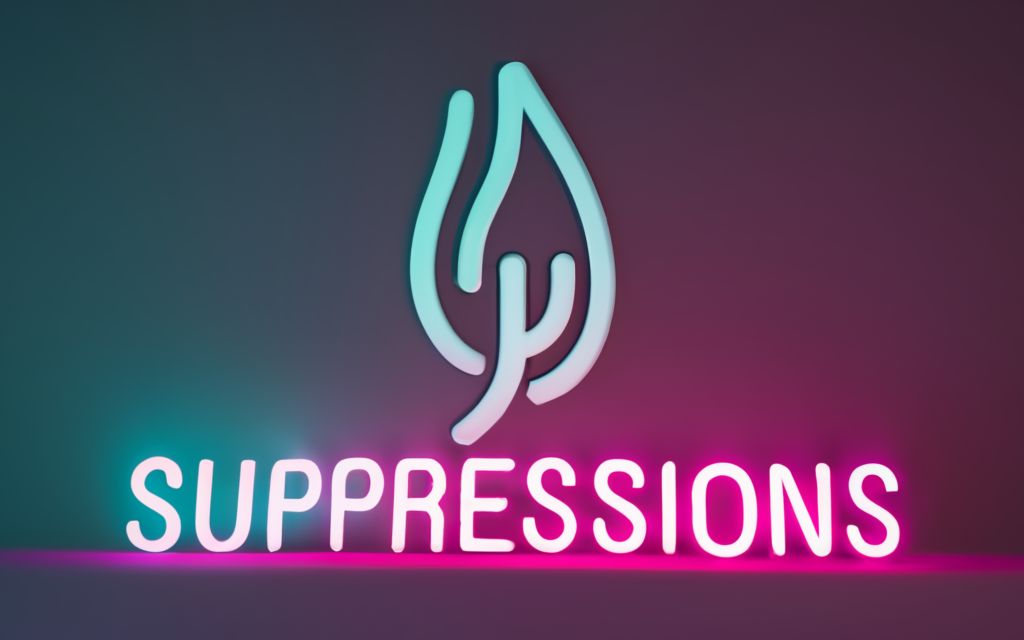Are pesky invalid emails, relentless bounces, and stubborn spam bots ruining your sender reputation and cluttering your lists? It’s suppression time! Managing suppressions is one of the most vital – but often neglected – ingredients for email success. Properly wield this deliverability superpower, and watch your campaigns flourish. Join us as we explore the suppression arsenal, revealing how to wield these tools to obliterate deliverability obstacles and open the floodgates to inboxes everywhere. With great suppression comes great deliverability. Let’s get started!
What are Suppressions in Email Marketing?
Suppressions play a vital role in email deliverability, allowing marketers to optimize their lists by removing problematic addresses. But what exactly are suppressions? Let’s start with a quick definition and overview.
Definition and Overview of Suppressions
A suppression is when an email address is added to a list that prevents future messages from being sent to it. Suppressions are triggered automatically when an email bounces, an address is flagged as invalid, or a recipient unsubscribes. By suppressing these addresses, marketers can avoid wasting resources and improve their sender reputation.
Suppressions are usually managed behind the scenes by the email service provider (ESP). For example, if an address in your MailChimp list hard bounces, MailChimp will automatically update that record to be suppressed. This prevents that address from receiving any more emails.
Suppressions are not necessarily permanent – they depend on the reason for blocking delivery. For instance, a temporary bounce due to a full inbox will lead to a temporary suppression. However, hard bounces often indicate a permanent issue, resulting in indefinite suppression.
Now that we’ve defined suppressions, let’s look at the main types you’re likely to encounter:
Types of Suppressions
There are a few core categories of suppressions in email marketing:
- Bounces – Triggered by bouncebacks, which occur when an email is rejected by the recipient’s mail server. There are two types of bounces:
- Hard bounces – Permanent rejections due to non-existent addresses. Leads to indefinite suppression.
- Soft bounces – Temporary rejections, like when an inbox is full. Leads to temporary suppression.
- Invalid Emails – Badly formatted, fake, or mistyped email addresses. These are suppressed indefinitely.
- Unsubscribes – Recipients can opt out of your emails by clicking unsubscribe links. Their addresses are then suppressed.
- Spam Reports – Recipients can mark your email as spam, leading to suppression. Too many spam reports can even get you blacklisted.
- Manual Suppressions – Marketers can manually suppress addresses by adding them to exclusion lists.
- Group Unsubscribes – Recipients can unsubscribe from specific email categories/groups. Their addresses are suppressed for those groups only.
- Domain Suppressions – Entire domains can be blocked if they generate too many bounces or spam complaints.
As you can see, there are many ways an address can end up suppressed. The most common are bounces and unsubscribes.
How Suppressions Differ from Unsubscribes
It’s easy to confuse suppressions and unsubscribes, but there is an important distinction. As we touched on earlier:
- Unsubscribes are opt-outs initiated by recipients clicking unsubscribe links in your emails. This suppresses their address.
- Suppressions are blocks applied by the ESP, often automatically due to bounces, spam complaints, invalid addresses, etc.
The end result is similar – the address is prevented from receiving future emails. However, unsubscribes are voluntary recipient actions, while suppressions include both automated and manual blocks applied by the sender/platform.
Understanding this difference is essential, because you have to process unsubscribes differently than pure suppressions:
- Unsubscribes must be honored immediately, or you risk spam complaints.
- With suppressions, you may be able to re-engage once the root cause is fixed.
The best practice is to regularly sync your suppression lists across all email platforms to maintain accuracy. Keep unsubscribes and opt-outs segmented in a separate exclusion list. Leverage suppression status to identify active subscribers for future campaigns.
Suppressions aren’t necessarily permanent – monitoring bounce reasons and spam trap hits can help you rehabilitate addresses. But remember, recipients control unsubscribes, so honor their opt-out requests right away.
Now that we’ve clarified what suppressions are, let’s look at why they matter for your sender reputation and inbox placement.

Why Suppressions Matter for Deliverability
Suppressions allow you to remove problematic addresses from your mailing lists, protecting your sender reputation and improving inbox placement and engagement rates. Let’s explore some of the key benefits of leveraging your suppression list.
Preventing Spam Complaints and Blacklisting
One of the fastest ways to wreck your deliverability is to keep sending emails to addresses that have unsubscribed or reported your messages as spam. This annoyance will likely prompt more spam complaints or even cause blacklisting.
By suppressing unengaged addresses, you reduce the likelihood of future complaints. This helps safeguard your domain and IP reputations, keeping your emails out of the spam folder.
Services like SpamCop track spam reports across providers. Too many flagged messages can get your domain or IP address added to real-time blackhole lists (RBLs). This makes other ESPs more likely to filter your mail to the spam folder.
Suppressions limit your exposure to spam reporting. Each unwanted email you don’t send avoids another complaint that could jeopardize your sender score.
Maintaining Sender Reputation
In a similar vein, suppressions help maintain your sender reputation with major ISPs like Gmail, Outlook, and Yahoo. These providers assign reputation scores based on engagement and complaint rates.
If you have too many unsubscribes, bounces, or marked spam from a domain, that signals your emails aren’t wanted. As a result, providers will lower your reputation, leading to more aggressive filtering.
By removing suppressed addresses, you avoid tanking your engagement metrics. This helps preserve your sender score so that future emails are more likely to bypass the spam filters and reach the inbox.
You can monitor your sender reputation with tools like SenderScore and Mail-Tester. Suppressions are key to keeping your ratings high.
Optimizing Open and Click-Through Rates
Suppressions also help optimize your open and click-through rates by focusing only on engaged subscribers.
Let’s consider an example:
You have a list of 100,000 subscribers, but 5,000 have bounced or unsubscribed. If you keep emailing all 100k contacts, your open and click rates will be diluted.
The 5,000 suppressed addresses won’t open or click your messages. But when aggregating stats across all 100k recipients, those non-actions bring down your overall rates.
By removing inactive addresses through suppressions, you have a more accurate view of engagement for your deliverable subscribers.
In our example, if you email just the 95,000 non-suppressed addresses, your open and click rates will be higher as they only consider active contacts.
This enables better optimization through testing – you can experiment with different subject lines, content, designs, etc and know the metrics reflect truly engaged recipients.
Of course, blindly suppressing every non-opener or non-clicker is not the answer. Intelligent list management is key – periodically re-engage lapsed contacts who may still be interested. Monitor ISP reputation and avoid aggressive list cleansing.
But used properly, suppression lists help concentrate on your active audience for better engagement benchmarks.
So in summary, leveraging suppressions has three big benefits:
- Avoiding spam complaints that could cause blacklisting
- Maintaining positive sender reputation with ISPs
- Removing inactive contacts to optimize open and click rates
Proper suppression list hygiene takes work, but pays dividends through improved inboxing and engagement. Next let’s look at ways to effectively manage suppressions in your email campaigns.
Managing Suppressions in Your Email Lists
To fully leverage your suppression lists, you need to properly manage and sync suppressions across channels. Here are some best practices for suppression list hygiene.
Importing and Exporting Suppression Lists
Most email service providers let you import or export suppressions in CSV format. This enables:
- Syncing – Maintain a canonical suppression list that you sync across ESPs.
- Backups – Download suppressions regularly as a backup.
- Platform Migration – Export suppressions when moving ESPs to retain list hygiene.
- Segmenting – Create separate CSVs for different suppression sources (bounces, unsubscribes, etc).
- Analysis – Inspect suppression trends in spreadsheet software.
Examples
Here are some examples of importing and exporting suppressions in popular ESPs:
- Mailchimp – Download suppressed subscribers from Audiences page. Re-upload CSV to reset suppression status.
- Constant Contact – Export global opt-outs from Preferences. Import bounces/unsubscribes under Contacts.
- GetResponse – Download suppressions from Tools. Re-upload edited CSV to sync.
- Aweber – Export and import suppressed subscribers from Advanced Tools.
- Campaign Monitor – Suppressions managed under Subscriber Lists menu.
Regularly importing and exporting suppressions enables full control over your list hygiene. You can then programmatically sync this canonical source across other platforms.
Updating Suppression Status in ESPs
In addition to bulk importing CSV lists, most ESPs provide ways to manually update suppression status for individual contacts.
These inline editing options are useful for:
- Overriding incorrect batch suppressions
- Unsuppressing subscribers who can be re-engaged
- Suppressing one-off abuse/complaint cases
Examples
Here are some ways to update per-subscriber suppression status:
- Mailchimp – Click the “Unsubscribed” tag to toggle suppression.
- Aweber – Change to Suppressed/Normal under Contact Details.
- ActiveCampaign – Toggle “Mark as Spam” on the Contact record.
- HubSpot – Use “Unsubscribed” checkbox on Contact profile.
- Sendinblue – Update suppression under Managing Contacts.
Leverage these in-line editing capabilities to fine tune suppression status rather than relying solely on broad imports. Segment suppressions to customize re-engagement campaigns for lapsed subscribers.
Leveraging Suppression List APIs
Most major ESPs provide developer APIs that enable programmatically managing suppressions.
Common API capabilities include:
- Updating suppression status in bulk
- Querying for suppressed contacts
- Adding/removing individual subscribers
- Automating sync with other systems
For example, you could build a script that:
- Pulls your canonical suppression sheet into a database
- Checks each record’s status in your ESP via API
- Updates any discrepancies to sync the lists
This allows suppressions to be version controlled and replicated accurately across platforms.
You can also leverage suppression APIs to segment campaigns. For instance, only targeting non-suppressed users through the API when sending a promotional email.
APIs provide flexibility – explore the options for your ESPs to enhance suppression workflows.
Checking Suppression Status in Workflows
Many email service providers let you check suppression status within workflows and conditional content.
You can branch based on whether a recipient address is suppressed. Use cases include:
- Send re-engagement series only to suppressed contacts
- Show unsubscribe options only for non-suppressed users
- Display “We’ve noticed you haven’t opened lately” if suppressed
This allows sending targeted content based on suppression state:
Branch based on suppression status to customize content
Some common ways to check suppression status:
- Mailchimp – Use the “Suppressed” tag in conditional content.
- SendGrid – Check
suppression_group_idin API/code workflows. - Constant Contact – Branch based on the “Opted Out” attribute.
- Klaviyo – Segment by the
is_unsubscribedproperty.
Treat suppression status like any other user attribute to deliver tailored messaging.
In summary, managing suppressions requires diligent hygiene across importing, exporting, editing, syncing, and leveraging APIs and workflows. Done consistently, this will pay dividends through improved deliverability and engagement.
Now let’s look at how to analyze and act on suppression data.

Using Suppressions to Improve Deliverability
Now that we’ve covered managing suppression lists, let’s discuss how to analyze suppressions and leverage the insights to improve your email deliverability.
Analyzing Suppression Data and Trends
The first step is digging into your suppression data to spot trends and anomalies. Here are some key reports to review periodically:
- Suppression rate – Percentage of list suppressed per campaign or period. Watch for spikes.
- Sources – Breakdown of suppressions by type (bounces, unsubscribes, etc). Indicates issues.
- Subscribers suppressed – Number and key attributes of newly suppressed contacts. See if particular segments are affected.
- Subscribers re-engaged – Reactivated subscribers who responded after suppression. Measure win-back effectiveness.
- Suppression causes – Specific bounce reasons, spam complaints sources, etc. Identify patterns.
- Unsuppression rate – Percentage of recipients switched from suppressed back to active. Benchmark progress.
Monitoring trends like weekly suppression rate or top sources enables early detection of deliverability problems. You can then drill down and troubleshoot issues while they are small and manageable.
Troubleshooting High Suppression Rates
If you notice suppression rates spiking above normal levels, here are some steps to troubleshoot:
- Audit recent changes – Review new content, links, design, subject lines, etc that could cause issues.
- Check for blocklisted URLs – Tools like MX Toolbox can identify if your links are flagged as spammy.
- Review spam complaints – Any feedback on reasons for spam reports like Poor Content? Offensive?
- Monitor by segment – See if suppressions skew toward specific subscriber groups to isolate causes.
- Inspect new forms – Any issues with new signup forms leading to fake or malformed emails?
- Analyze bounces – Notice spikes in certain bounce categories like No Mailbox? Host Unknown?
- Check reputation scores – Higher volumes of spam complaints can tank sender reputation.
Address any identified issues, like removing problematic links or correcting broken forms. Follow up with re-engagement and self-service suppressions removal to recover valid addresses.
Continual suppression analysis lets you respond quickly if deliverability dips so you can course correct.
Balancing Suppressions and Unsubscribes
It can be tempting to aggressively suppress every non-opener and non-clicker to inflate your engagement rates.
Avoid this temptation! Intelligent list management is about finding the right balance between suppressions and unsubscribes.
Too many unsubscribes means recipients don’t feel in control. Too many unnecessary suppressions damages long-term engagement.
Aim to have most inactive users organically unsubscribe themselves. Reserve manual suppressions for:
- Bounces and invalid emails
- Extreme abuse and spam complaints
- Total non-engagement after re-engagement attempts
Don’t suppress engaged recipients who simply didn’t open or click one particular email. Maintain subscriber trust by allowing them to opt out rather than suppressing hastily. Monitor ISP reputation and keep overall suppression rates in check.
When to Retry Sending to Suppressed Addresses
Not all suppressions are permanent. For temporary bounces or disabled spam traps, re-engagement can recover subscribers.
Use these general guidelines on timing for retrying suppressed addresses:
- Soft bounces – Retry every few days up to 2 weeks.
- Transient failures – Retry every few hours up to 72 hours.
- Reputation issues – Retry after 1-2 months once resolved.
- List hygiene bounces – Retry after confirming valid address.
- Invalid addresses – Do not retry.
- Abuse reports – Do not retry without explicit consent.
- Unsubscribes – Only retry with recipient’s permission.
Do not repeatedly send to suppressed addresses that cannot receive your mail. This wastes resources and damages deliverability.
Segment your suppression list and customize your re-engagement strategy based on suppression reason and duration.
In summary, regularly analyze your suppression data, balance list pruning, and selectively retry addresses when appropriate to continually improve deliverability.
Best Practices for Leveraging Suppressions
Managing suppressions effectively takes work, but following some core best practices will maximize their impact on your email program.
Regularly Update and Sync Suppression Lists
As discussed previously, don’t let your suppression lists stagnate. Get into a cadence of periodically:
- Exporting the full list from your ESP
- Checking for any opt-outs collected from forms
- Importing back any new additions
- Confirming accurate sync status
Ideally, perform this hygiene workflow weekly or bi-weekly. Automating the process via scripts and APIs helps maintain consistency.
In addition, sync suppressions across all platforms – your email tool, CRM, site forms, etc. Identify your canonical suppression source, then focus on replicating it accurately everywhere through APIs.
Don’t silo suppressions in individual systems. Consistent synchronization is vital to honoring opt-outs and protecting your reputation.
Use Suppressions to Segment Active Subscribers
Segmenting helps target the right messages to the right recipients. Suppression status provides useful data for dividing your list.
Some example segments based on suppression include:
- Active subscribers – All non-suppressed and re-engaged contacts. Focus promotional messaging here.
- Engaged subscribers – Opened or clicked in the last 30-90 days. Send special offers and announcements.
- Passive subscribers – No opens or clicks for 30-90 days. Send re-engagement content.
- Suppressed subscribers – Bounced, reported spam, unsubscribed, etc. Send win-back campaigns according to reason.
- Recovered subscribers – Re-engaged after temporary suppression. Watch engagement closely.
appropriately. Do not send promotional blasts to suppressed and passive groups. Tailor content to be useful based on their status.
Consider Automated Suppression Workflows
Leveraging your ESP’s workflow builder can help automate suppression management.
Possible workflows include:
- New subscriber onboarding – Check for recycled email patterns, validate format, confirm engagement on first send. Suppress any high risk addresses.
- Spam complaints – Automatically suppress any addresses who report your mail as spam after customized re-engagement attempts.
- Bounce processing – Categorize bounce reasons, recycle, and suppress invalid addresses. Retry soft bounces.
- Re-engagement – Trigger specific re-welcome, win-back campaigns for suppressed segments based on reason and duration.
- List hygiene – Regularly scan for risky email patterns and update suppression status.
These automation flows handle routine suppression tasks in the background, freeing you up for higher value efforts.
Review Root Causes of Suppressions
It’s easy to focus just on managing the mechanical side of suppressions. But often you need to look at the source:
- Why are subscribers reporting your mail as spam?
- What causes addresses from a domain to start hard bouncing?
- How did so many fake email addresses get on your list?
Analyze the root factors driving suppressions so you can address the causes rather than just the symptoms.
This may uncover issues like:
- Sending from a problematic IP address
- Using spam trigger terms without realizing it
- Not confirming opt-in consent on a form
Tackling these systemic problems will alleviate suppressions at their source rather than endlessly managing the fallout.
In summary, stay vigilant with suppression list hygiene, leverage segments, explore automation, and audit the reasons behind your suppressions. This comprehensive approach will maximize the value of your suppression workflow.
Now let’s connect suppressions back to your broader deliverability strategy.

Suppressions as Part of an Overall Deliverability Strategy
Suppressions are not a standalone tactic – they need to fit into your broader email deliverability strategy. Let’s discuss how suppressions integrate with other components like re-engagement and brand messaging.
Combining with Other Deliverability Tactics
To maximize deliverability, suppressions should be used alongside:
- Authentication – Implement SPF, DKIM, and DMARC to validate your domain and IP. This builds trust with ISPs.
- Reputation monitoring – Keep tabs on your sender score and blacklist status to stay off filters.
- List growth – Balance suppressions with active acquisition and re-engagement to grow your subscriber base.
- Content strategy – Well-targeted content reduces spam complaints and unsubscribes resulting in fewer suppressions.
- Inbox placement monitoring – Use seed accounts to confirm your emails land in the primary inbox across providers.
- Sending infrastructure – Invest in quality ESPs, IP addresses, and internet connectivity to maximize uptime and deliverability.
- Email authentication – Implement confirmation opt-in processes during subscriber acquisition to ensure valid engaged addresses.
Proper suppression management is not a silver bullet. Combine it with these additional tactics for the best overall email deliverability.
Integrating with Re-Engagement Campaigns
We’ve touched on using suppressions lists to inform re-engagement efforts. This integration is vital for full effectiveness.
Work suppressed status into re-engagement workflows and segments to maximize response. Examples include:
- Triggering a “We’ve missed you” series for short-term suppressed subscribers.
- Sending a final “Goodbye” message before permanent suppression for non-responsive contacts.
- Customizing copy based on suppression reason – inbox overcrowded vs. spam complaint.
- Testing timing and content tailored to suppression type and duration.
- Capping retry frequency to avoid further issues.
- Monitoring performance by suppression source to refine future win-back attempts.
Do not over-email or spam lapsed subscribers. Personalize the approach using suppression insights without being intrusive.
Aligning with Brand Messaging Guidelines
How you talk about suppressions also matters for your brand image.
Some tips on messaging:
- Lead with empathy first in re-engagement campaigns. “Haven’t heard from you, is everything OK?”
- Take responsibility for over emailing or poor content quality if applicable. “Apologies if we overdid it recently.”
- Remind subscribers they’re in control. “No problem if our news isn’t relevant anymore.”
- For inactive segments, position cleaning as for their benefit. “We want to update our records to avoid bothering you.”
- Stress your goal is useful communication, not just promotions. “We’d love to reconnect and share valuable updates if you’re interested.”
- Offer easy suppressions management. You can manage your preferences or unsubscribe at any time.
Suppress thoughtfully and talk to recipients respectfully. Make subscriber experience and choice a priority over aggressive list growth.
In summary, integrate suppressions holistically across your programs as a piece of an overall coordinated deliverability and branding strategy.
Next let’s wrap up with some key takeaways.
Key Takeaways on Using Suppressions Effectively
Let’s recap some of the core advice around leveraging suppressions for email success.
Recap of Best Practices
To quickly summarize key learnings:
- Export, import, and sync suppression lists across ESPs regularly.
- Leverage APIs and workflows to automate suppression management.
- Analyze suppression types, sources, rates, and trends frequently.
- Balance suppressions with voluntary recipient unsubscribes.
- Segment properly based on suppression status and reason.
- Customize re-engagement content for suppressed contacts.
- Retry temporary bounces and spam traps in moderation after fixing root causes.
- Combine suppression hygiene with authentication, monitoring, content, and infrastructure.
- Integrate suppressions into your overall re-engagement and branding strategies.
- Prioritize subscriber experience over aggressive list growth.
Following these best practices helps ensure you wield suppressions effectively and ethically.
Main Benefits of Suppression Management
Robust suppression list management delivers significant benefits:
- Protects your domain and IP reputations with ISPs, preserving inbox placement.
- Reduces spam complaints and unsubscribes by removing problem addresses.
- Improves open rates, click-throughs, and engagement metrics by focusing on active subscribers.
- Saves resources and cost by avoiding emailing addresses that cannot receive mail.
- Provides insights to enhance targeted re-engagement efforts.
- Automates tedious list hygiene tasks to focus your time better.
Healthy suppressions ultimately mean more of your emails reach engaged recipients who drive your business goals.
Future of Suppression and Deliverability
Looking ahead, constantly improving deliverability will be an ongoing necessity:
- Increasing competition means maximizing reach is essential for ROI.
- Stricter regulations like CAN-SPAM require stringent consent and list management.
- More sophisticated filtering by ISPs means focusing on reputation is mandatory.
- User demand for control over inboxes raises the bar on suppression tools.
- Automation and AI grant new abilities to optimize based on data like suppressions.
The core principles of honoring user choice and focusing on permission over volume will only grow more important. By laying the right suppression foundations now, you position yourself to navigate the shifting deliverability landscape and thrive.
So in summary, manage your suppression lists diligently – but also intelligently. Obsess over the health of your lists, but remember the individuals behind each address. Do all you can to reach inboxes, but put your recipients first. Stick to that ethos, and suppressions will propel your email success as we move forward.
We covered a lot of ground here – hope this gives you new ideas on how to leverage suppressions for stellar deliverability. Reach out with any other questions!

Key Takeaways on Optimizing Email Deliverability with Suppressions
Leveraging suppressions effectively is crucial for maintaining stellar email deliverability.
To recap key learnings:
- Suppressions allow you to remove non-deliverable and inactive addresses to improve inbox placement.
- Implement robust suppression workflows across importing, exporting, API integration, and automation.
- Analyze suppression types, sources, trends, and root causes regularly to guide improvements.
- Balance aggressive list pruning with retaining engaged recipients.
- Use custom suppression status segmentation to target relevant messaging.
- Craft tailored re-engagement content for suppressed contacts when appropriate.
- Combine suppression management with authentication, reputation monitoring, content strategy and other tactics.
- Remember the individuals behind each email address and honor their preferences.
Healthy suppression list hygiene takes continual vigilance, but pays off exponentially through improved sender reputation, increased engagement, optimized campaigns, and reduced costs from wasted sends.
Treat your recipients with respect, but without suppressions, your deliverability will suffer – losing you visibility, ROI, and customer trust over the long-term.
Strike the right equilibrium for your program, stay current with evolving regulations and ISP capabilities, keep your recipients’ experience central, and suppressions will provide a foundation to reach inboxes for years to come.
Frequently Asked Questions About Suppressions
What are the main benefits of suppression list management?
There are several key benefits:
- Improves deliverability by removing risky addresses prone to bouncing or complaints
- Optimizes campaigns by focusing only on engaged, active contacts
- Saves costs by reducing wasted sends to invalid emails
- Provides insights by tracking suppression types, sources, and trends
- Protects sender reputation with ISPs to avoid spam folder filtering
- Automates tedious list hygiene tasks to focus time on other initiatives
How often should I sync and update my suppression lists?
Ideally every 1-2 weeks. The frequency depends on your list size and email volume, but at minimum sync suppressions monthly. Relying on outdated exclusion lists hurts deliverability.
What’s the best way to remove an address from the suppression list?
If the subscriber requests it, the best practice is to export the full suppression list, remove them, then reimport the updated CSV. Avoid manually overriding individual suppressions unless necessary to maintain accuracy.
When should I retry sending to a suppressed email address?
It depends on the reason and duration of suppression:
- Soft bounces can be retried for up to 2 weeks.
- Transient failures can retry every few hours for 72 hours.
- List hygiene bounces can retry after validation.
- Reputation-based suppressions retry after 1-2 months.
- Invalid and abuse suppressions should not be retried without permission.
How do I automate suppression management?
Leverage your ESP’s APIs, workflows, and pre-built integrations to sync with your CRM, manage statuses in bulk, trigger re-engagement campaigns, and handle repetitive hygiene tasks automatically.
What’s the difference between suppressions and unsubscribes?
- Suppressions are blocks applied by the sender, often due to issues like bounces.
- Unsubscribes are recipient opt-outs by clicking unsubscribe links in your emails.
Both have the same end result of removing an address, but unsubscribes are voluntary. Honor them immediately while some suppressions can be temporary and re-engaged if issues are fixed.
Should I aggressively suppress every inactive contact?
No – balance list quality with retaining engaged recipients. Non-openers or non-clickers of one email may be interested long-term. Remove addresses thoughtfully based on consistent non-engagement indicators, not single email interactions.
How can I tell if my suppression workflow is working?
Key metrics to monitor are lower complaint rates, higher open/click rates relative to sends, increased re-engagement campaign performance, and improved inbox placement over the long run.
How do I export, import, and sync suppressions with my ESP?
Most major providers like Mailchimp, Constant Contact, Campaign Monitor, etc. provide options to export suppressions as a CSV file, edit the file externally, and re-import the contacts to sync status. Refer to your ESP’s documentation for specifics.

